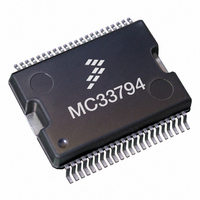MC33794EKR2 Freescale Semiconductor, MC33794EKR2 Datasheet - Page 11

MC33794EKR2
Manufacturer Part Number
MC33794EKR2
Description
IC SENSOR ELECTRIC FIELD 54SOICW
Manufacturer
Freescale Semiconductor
Type
Sensor Interfacer
Datasheet
1.MC33794EK.pdf
(18 pages)
Specifications of MC33794EKR2
Input Type
Logic
Output Type
Logic
Interface
ISO9141
Current - Supply
7mA
Mounting Type
Surface Mount
Package / Case
54-SOIC (7.5mm Width) Exposed Pad, 54-eSOIC, 54-HSOIC
Maximum Operating Temperature
+ 85 C
Mounting Style
SMD/SMT
Lead Free Status / RoHS Status
Lead free / RoHS Compliant
Other names
MC33794EKR2
MC33794EKR2TR
MC33794EKR2TR
Available stocks
Company
Part Number
Manufacturer
Quantity
Price
Company:
Part Number:
MC33794EKR2
Manufacturer:
ROHM
Quantity:
3 200
Part Number:
MC33794EKR2
Manufacturer:
FREESCALE
Quantity:
20 000
using an electric field. The IC generates a low radio
frequency sine wave. The frequency is set by an external
resistor and is optimized for 120 kHz. The sine wave has very
low harmonic content to reduce potential interference at
higher harmonically related frequencies. The internal
generator produces a nominal 5.0 V peak-to-peak output that
is passed through an internal resistor of about 22 kΩ. An
internal multiplexer routes the signal to one of 11 terminals
under control of the ABCD input terminals. A receiver
multiplexer simultaneously connected to the selected
electrode routes its signal to a detector, which converts the
sine wave to a DC level. This DC level is filtered by an
external capacitor and is multiplied and offset to increase
sensitivity. All of the unselected electrode outputs are
grounded by the device. The current flowing between the
selected electrode and the other grounded electrodes plus
other grounded objects around the electrode causes a
page 2, for a graphic representation of the block diagram
information in this section.
OSC
frequency is controlled by a resistor attached to R_OSC. The
normal operating frequency is around 120 kHz. A square
wave version of the frequency output is available at CLK.
Timing for the Power-ON Reset and watchdog (POR/WD)
circuit are derived from this oscillator’s frequency.
MUX OUT
nine possible electrode outputs or two reference terminals.
All unused terminals are automatically grounded (except the
two reference terminals). The selected output is controlled by
the ABCD inputs.
ELECTRODES E1-E9
either directly or through coaxial cables to the electrodes for
measurements. Every electrode has a 2.8K (
in series with the external pad and the internal electronics.
Only one of these electrodes can be selected at a time for
capacitance measurement. All of the other unselected
electrodes are switched to ground by an internal switch that
has an internal on-resistance of approximately 700
signal at the selected electrode terminal is routed to the
shield driver amplifier by an internal switch. All of the coaxial
cable shields should be isolated from ground and connected
SHIELD.
Sensors
Freescale Semiconductor
The MC33794 is intended for use in detecting objects
Refer to
This section generates a high purity sine wave. The center
This circuit directs the output of the sine wave to one of
These are the electrode terminals. They are connected
Figure
1, MC33794 Internal Block Diagram,
FUNCTIONAL DESCRIPTION
BLOCK DIAGRAM COMPONENTS
±
20%) resistor
Ω
. The
INTRODUCTION
voltage drop across the internal resistance. Objects brought
into or out of the electric field change the current and resulting
voltage at the IC terminal, which in turn reduces the voltage
at LP_CAP and LEVEL.
capacitance caused by using coaxial cables to connect to
remote electrodes. By driving the coax shield with this signal,
the shield voltage follows that of the center conductor,
significantly reducing the effective capacitance of the coax
and maintaining sensitivity to the capacitance at the
electrode.
microcontroller. It provides two voltage regulators, a Power-
ON-reset/out-of-range voltage detector, watchdog circuit,
lamp driver and sense circuit, and a physical layer ISO-9141
communications interface.
REF_A & REF_B ELECTRODES
through E9. Unlike E1 through E9, these terminals are not
grounded when not selected. Both terminals have a 2.8K
(
internal electronics. The purpose of these terminals is to
allow known capacitors to be measured. By using capacitors
at the low and high end of the expected range, absolute
values for the capacitance on the electrodes can be
computed. These terminals can be used for electrodes E10
and E11 with the only difference is that these two electrodes
will not be grounded when not selected.
SHIELD DRIVE
signal from the electrode. Since it nearly has the same
amplitude and phase as the electrode signal, there is little or
no potential difference between the two signals thereby
cancelling out any electric field. In effect, the shield drives
and isolates the electrode signal from external virtual
grounds. A common application is to connect the Shield Drive
to the shield of a coax cable used to connect an electrode to
the corresponding electrode terminal. Another typical use is
to drive a ground plane that is used behind an array of touch
sensor electrodes in order to cancel out any virtual grounds
that could attenuate the AC signal.
MUX IN
one of two internal nodes to an amplifier/detector. The
selection is controlled by the ABCD inputs and follows the
driven electrode/reference when one is selected.
±
20%) resistor in series with the external pad and the
A shield driver is included to minimize the effect of
The MC33794 is made to work with and support a
These terminals can be individually selected like E1
This circuit provides a buffered version of the returned AC
This circuit connects the selected electrode, reference, or
MC33794
11










